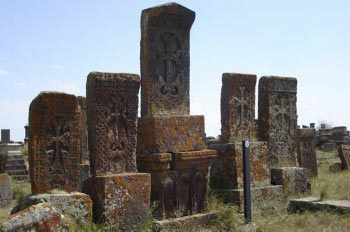By Karine Ionesyan – ArmeniaNow.com
Tuesday (September 7), AMAP hosted a ceremony in the village of Noratus, in the Gegharkunik region, to unveil the seven panels, and marking AMAP’s 36 site for which such information has been made available since the project began in 2008. (The NGO is sponsored by VivaCell-MTS communications company and by the Honorary Consul of Italy.)
The initiative and shared funding for Noratus came from the U.S. Ambassador’s Fund for Cultural Preservation, and U.S. Ambassador Marie Yovanovitch attended the joint presentation at the site. A 250-meter protective and decorative fence has been installed around the cemetery to protect the field mainly from grazing cattle. Other improvements include erosion control, area greening, a new stair case at the entrance, asphalt, and a visitor and handcrafts center.
The historic part of the cemetery has 800 khachkars dating to 7th-19th centuries, the tradition though is continued in the new cemetery, where elaborate khachkars are placed above tomb-stones. Each khachkar is unique both in its design and the story it holds.
From young to old in the village know that if two crosses are carved on a khachkar, it means that a husband and wife are buried there, and the small crosses next to it symbolize the number of their children.
“All khachkars face west, because the deceased was always buried so as to face the khachkar, i.e. face East, towards God and be reborn with every sunrise, so the cross-stone symbolizes birth and life,” Rafik Asoyan, 80, explained to ArmeniaNow.
Asoyan and his entire family are engaged in khachkar making. He is one of the elderly villagers who had provided some of the information that appeared on the AMAP panels.
Many in Noratus are involved in khachkar production and there is no grave that would not have a khachkar made by one of about 10 specialists in any of the village’s five workshops.
Head of the Gegharkunik Diocese of the Armenian Apostolic Church Bishop Mark Hovhannisyan says the cemetery “has a spiritual and cultural value and national history. For many it is a museum, or a place of pilgrimage, but most importantly, each of the khachkars reminds us that we ought to be the masters of our national and religious heritage.”
“If every visitor picks just one piece of litter when visiting the area, it will be preserved,” he added.
AMAP plans its next installation at Akhtala Monastery, after which the project will close the year with a presentation at Erebuni Museum in Yerevan.











